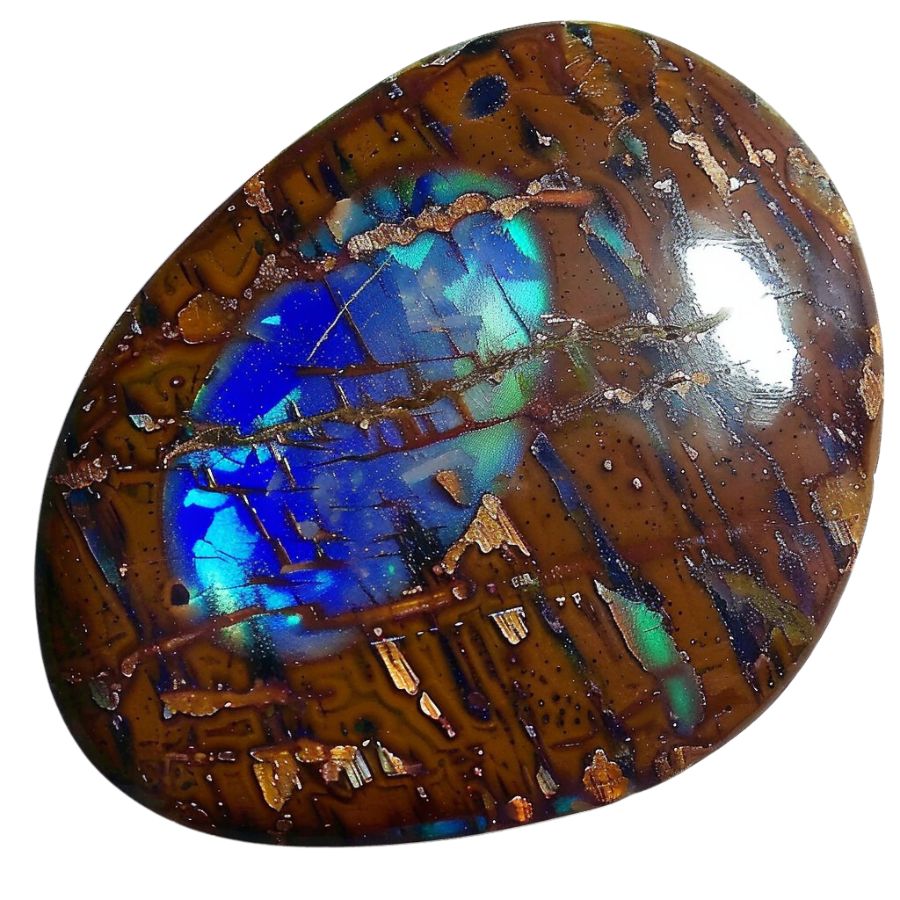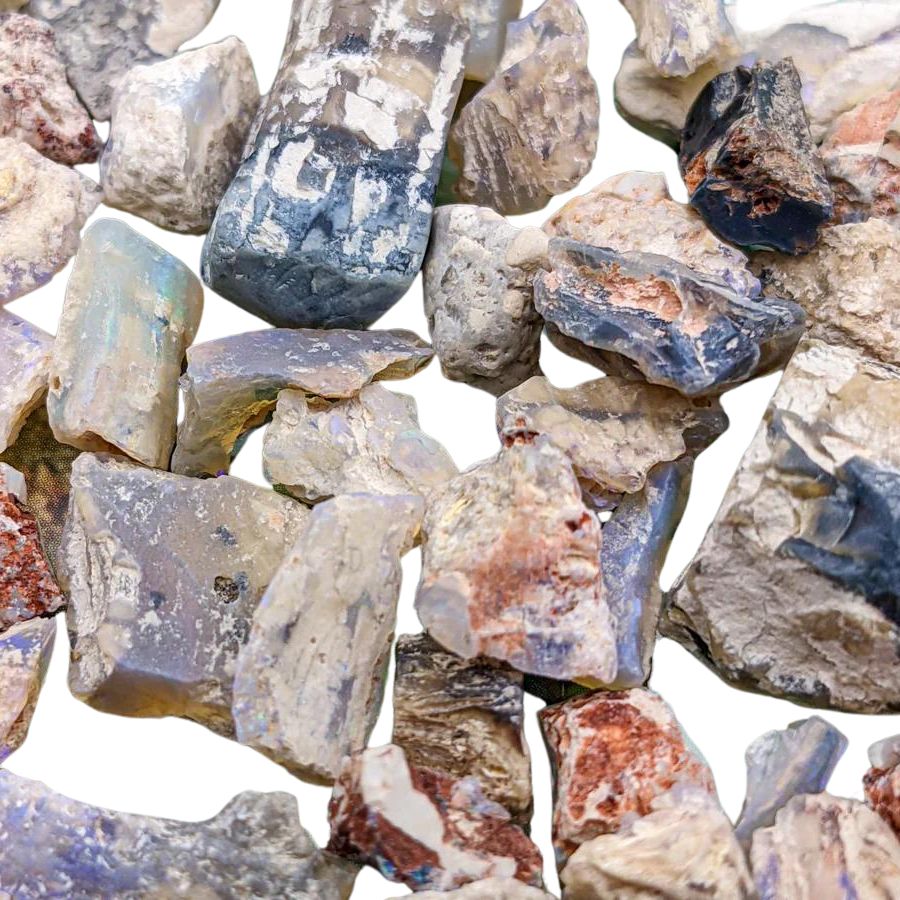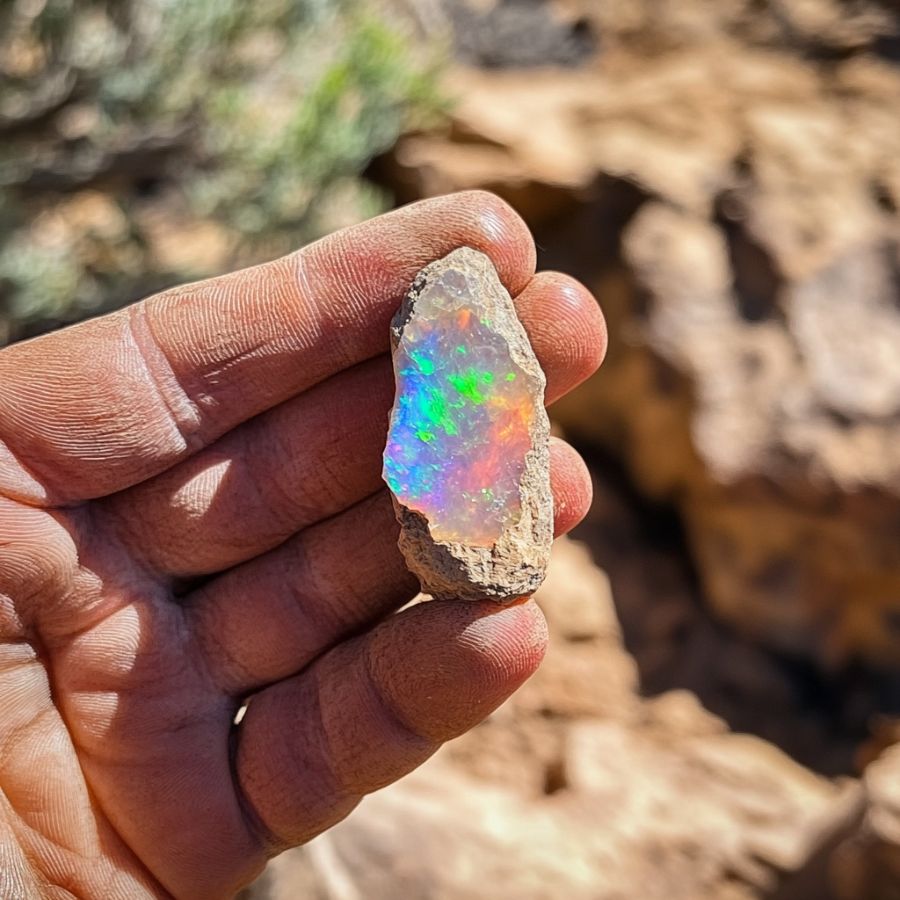Iowa’s landscape was carved by massive glaciers over 12,000 years ago, leaving behind unique geological formations that still surprise rock hunters today.
While Iowa isn’t famous for opals like Australia, dedicated rockhounds have found some interesting specimens in unexpected places across the state. The thrill of discovering these colorful gems makes the hunt worthwhile.
We’ve done the hard work for you by talking to local collectors and geology experts. Our list covers the most promising spots where you’re likely to find opals in Iowa.
How Opal Forms Here
Opal forms here through a fascinating natural process. When water containing silica seeps into cracks and voids in rocks, it begins to evaporate, leaving behind tiny silica spheres.
Over time, these spheres stack in a grid-like pattern, creating opal. This process can take millions of years!
The colors in opal come from the way light refracts through the silica spheres. Different conditions in the ground, like the type of rock and the presence of other minerals, can affect the opal’s type, color, and quality.
The Types Of Opal
There are several incredible types of Opal that can be found in the US as well as in our state. Each is uniquely beautiful and interesting including:

Common Opal
Common opal, also known as “potch,” stands out from other types of opal due to its lack of play-of-color, the iridescent display seen in precious opal. Instead, common opal features consistent, solid colors like white, pink, yellow, green, and blue.
It typically has a waxy to pearly luster and ranges from opaque to translucent. To identify common opal, look for its uniform color and absence of the shimmering color flashes found in precious opal.
Common opal forms under similar geological conditions as other opals, where silica-rich water seeps into rock cavities and slowly hardens over time. This process usually occurs in areas with volcanic activity or hot springs, where silica deposits are prevalent.

Fire Opal
Fire opal is known for its warm, vibrant colors, ranging from yellow and orange to deep red. Unlike precious opal, fire opal may or may not display the play-of-color, but its fiery body color makes it unique.
To identify fire opal, look for its bright, translucent to transparent appearance and the absence or presence of play-of-color within the warm hues.
Fire opal forms in volcanic regions where water rich in silica interacts with hot lava, filling cavities and fractures within the rock. Over time, the silica solution hardens, creating opal.
Visually, fire opal’s appeal lies in its vivid, flame-like colors that can be either uniform or exhibit internal flashes of color.

Boulder Opal
Boulder opal forms within the ironstone boulders of its host rock. Unlike other opals, boulder opal features precious opal veins intertwined with the natural rock, creating a beautiful contrast.
This opal is distinguished by its combination of colorful opal patches and the surrounding matrix, which can include ironstone or sandstone. To identify boulder opal, look for its vibrant play-of-color within the darker host rock, often showcasing brilliant blues, greens, and reds.
Boulder opal forms in sedimentary environments where silica-rich water infiltrates cracks and voids within ironstone or sandstone boulders. Over time, the silica hardens into opal, often creating thin seams or patches within the rock.

Hyalite Opal
Hyalite opal, also known as water opal, is a transparent to translucent type of opal that is distinctive for its glass-like appearance and lack of play-of-color. Unlike precious opal, which displays a rainbow-like iridescence.
You can identify hyalite opal by its clear to milky appearance, often with a slight green or blue fluorescence under UV light.
Hyalite opal forms in low-temperature hydrothermal environments, typically in volcanic regions. It precipitates from silica-rich fluids that fill cracks and voids in the host rock. This process can occur relatively quickly compared to other opal types.
Visually, hyalite opal resembles droplets of water or glass, often appearing as smooth, botryoidal (grape-like) formations. Its transparent nature makes it unique among opals, and its slight fluorescence adds to its allure.

Black Opal
Black opal is a rare and highly prized variety known for its dark body tone, which enhances the vibrant play-of-color. Unlike other opals, black opal has a deep background color, ranging from dark gray to jet black, making the iridescent colors more striking.
To identify black opal, look for its intense, dark base color coupled with brilliant flashes of blues, greens, reds, and other hues.
The presence of iron and carbon contributes to its dark body color. In the United States, black opal is primarily found in the Virgin Valley of Nevada, known for its rich opal deposits.

Crystal Opal
Crystal opal is known for its transparent to translucent body, which allows the play-of-color to shine through brilliantly. Unlike common opal, which is opaque, crystal opal’s clear or semi-clear nature enhances its vibrant internal colors.
To identify crystal opal, look for its see-through quality combined with flashes of color that can include blues, greens, reds, and more.
Its unique transparency sets crystal opal apart, making it a favorite among gem enthusiasts and collectors for its ethereal beauty.

Wood Opal (Opalized Wood)
Opalized wood is a fascinating form of petrified wood where the organic material has been replaced by opal. Unlike other opals, opalized wood retains the original structure and texture of the wood, creating a unique blend of organic and mineral elements.
To identify opalized wood, look for its wood grain patterns and opalescent sheen, often displaying a range of colors from white and brown to vibrant reds and greens.
Opalized wood forms under specific conditions where wood is buried in silica-rich sediment. Over millions of years, the silica solution gradually replaces the organic wood material with opal, preserving the wood’s original structure in stunning detail.

Contra Luz Opal
Contra Luz opal reveals its vibrant play-of-color when illuminated from behind. Unlike other opals, which display their colors through surface reflection, contra luz opal’s brilliance comes to life with transmitted light.
To identify contra luz opal, hold the gem against a light source and observe the internal flashes of color, which can include vivid reds, blues, greens, and purples.
This opal forms in volcanic environments where silica-rich water infiltrates cracks and cavities in the host rock. As the water evaporates, it leaves behind silica deposits that eventually solidify into opal.
Visually, contra luz opal appears nearly clear or milky when viewed without backlighting. However, when backlit, it displays stunning, colorful patterns that seem to glow from within.
What Rough Opal Looks Like
When you’re out looking for rough opal on your own it’s important to know what you’re looking for.
If you want REAL results finding incredible rocks and minerals you need one of these 👇👇👇
Finding the coolest rocks in isn’t luck, it's knowing what to look for. Thousands of your fellow rock hunters are already carrying Rock Chasing field guides. Maybe it's time you joined the community.
Lightweight, mud-proof, and packed with clear photos, it’s become the go-to tool for anyone interested discovering what’s hidden under our red dirt and what they've already found.
Join them, and make your next rockhounding trip actually pay off.
What makes it different:
- 📍 Find and identify 140 incredible crystals, rocks, gemstones, minerals, and geodes across the USA
- 🚙 Field-tested across America's rivers, ranchlands, mountains, and roadcuts
- 📘 Heavy duty laminated pages resist dust, sweat, and water
- 🧠 Zero fluff — just clear visuals and straight-to-the-point info
- ⭐ Rated 4.8★ by real collectors who actually use it in the field
This is what you need to look out for:
Look for exteriors like this

Look for play-of-color

Opal can display a range of colors, but what sets precious opal apart is its play-of-color—vivid flashes of multiple colors that change with the angle of light. Even in rough form, you might see hints of these colors peeking through.
Common opal lacks this feature and typically appears as a solid color like white, blue, or pink.
Check for a glassy or waxy luster

Opal often has a distinctive glassy or waxy luster. When you find a potential opal, examine its surface.
It should look shiny and smooth, almost like glass, even if it is still encased in a matrix or rough exterior.
Assess the density and weight

Opal is generally lighter than rocks of a similar size. When you pick up a piece of rough opal, it should feel lighter than expected.
Additionally, opal is relatively soft, with a Mohs hardness of 5.5 to 6.5, so it can be scratched more easily than quartz or other harder minerals.
A Quick Request About Collecting
Always Confirm Access and Collection Rules!
Before heading out to any of the locations on our list you need to confirm access requirements and collection rules for both public and private locations directly with the location. We haven’t personally verified every location and the access requirements and collection rules often change without notice.
Many of the locations we mention will not allow collecting but are still great places for those who love to find beautiful rocks and minerals in the wild without keeping them. We also can’t guarantee you will find anything in these locations since they are constantly changing.
Always get updated information directly from the source ahead of time to ensure responsible rockhounding. If you want even more current options it’s always a good idea to contact local rock and mineral clubs and groups
Tips on where to look
Once you get to the places we have listed below there are some things you should keep in mind when you’re searching:
Search in Sedimentary Rock Formations

Opal can also form in sedimentary rock formations where silica deposits have accumulated over time.
Focus on areas with ancient lake beds or clay deposits, as these environments are conducive to opal formation.
Check Dry Creek Beds and Gullies

Dry creek beds and gullies can be excellent places to find opal, as water flow can erode and expose opal-bearing rocks.
Look for exposed rock and gravel in these areas, especially after rainfall or seasonal flooding.
Investigate Old Mining Sites

Abandoned or historical mining sites can be rich in opal and other minerals. These areas often have tailings and discarded rock that may still contain opal.
Always seek permission if the land is privately owned and follow safety guidelines.
Look for Indicator Minerals

Certain minerals can indicate the presence of opal. Look for rocks and soil containing ironstone, sandstone, or clay, as these materials often coexist with opal deposits.
Additionally, finding quartz or chalcedony can suggest nearby opal.
Some Great Places To Start
Here are some of the better places to start looking for Opal in Iowa:
Always Confirm Access and Collection Rules!
Before heading out to any of the locations on our list you need to confirm access requirements and collection rules for both public and private locations directly with the location. We haven’t personally verified every location and the access requirements and collection rules often change without notice.
Many of the locations we mention will not allow collecting but are still great places for those who love to find beautiful rocks and minerals in the wild without keeping them. We also can’t guarantee you will find anything in these locations since they are constantly changing.
Always get updated information directly from the source ahead of time to ensure responsible rockhounding. If you want even more current options it’s always a good idea to contact local rock and mineral clubs and groups
Mississippi River

The Mississippi River flows along Iowa’s eastern border, creating a natural boundary with Illinois. The river’s path through Iowa features many gravel bars and sandy beaches that are perfect for rockhounding.
The best places to search for opals are the gravel bars that form on the inner curves of the river. These spots collect minerals and stones as the river deposits sediment.
Look carefully through the gravelly areas after periods of low water, when more riverbed is exposed. Spring and fall are usually the best seasons for searching, as water levels tend to be lower.
The areas around Bellevue and Dubuque are particularly good spots, as the river bends create large gravel deposits here. These sections have historically yielded various minerals including opals.
Humboldt area

Humboldt area sits in north-central Iowa, about 25 miles south of the Minnesota border. The region spreads across 435 square miles of varied terrain shaped by ancient glaciers. The land here tells an interesting story of Iowa’s ice age past.
The area is part of the Des Moines Lobe, a special geological zone created when glaciers moved through Iowa thousands of years ago. These glaciers left behind unique features like moraines (hills of rock and soil) and kettles (deep holes in the ground).
The ground beneath Humboldt is rich with limestone and dolomite. Rock collectors often explore the limestone areas because they can hold various minerals.
The area has a history of mining different materials like limestone, sand, gravel, and clay. While looking for opals, rockhounds often check glacial deposits and areas where limestone breaks through the surface.
Keokuk Geode Region

The Keokuk Geode Region spreads across southeastern Iowa, where the Mississippi and Des Moines Rivers meet. This area stands out as one of Iowa’s top spots for rock collectors because of its special geodes.
The area’s geology comes from the Lower Warsaw Formation, which formed millions of years ago during the Mississippian period.
What makes this place special is its round, hollow geodes that hold beautiful crystals inside. These geodes often contain different minerals like quartz, calcite, and sometimes opal.
The best places to look for stones are along creek beds and small streams that flow into the Mississippi River. The creek banks often show layers of limestone where minerals are hidden.
Fayette area

Fayette is located in northeast Iowa, known for its unique landscape that stands out from the rest of the state. The area is part of the Paleozoic Plateau, with exposed bedrock and deep valleys that make it different from Iowa’s typically flat terrain.
You can find many rock formations here, especially the Warsaw Shale layers that are famous for geodes. The soil and rocks in this area come from very old sea beds that existed millions of years ago.
Local streams and river channels have gravel pits that are good spots for finding minerals. Road cuts and quarries in the area have exposed layers of rock that contain various minerals.
Besides opals, rockhounds often find calcite, galena, and selenite here. The stream beds are particularly good places to look.
Places Opal has been found by county
After discussing our top picks, we wanted to discuss the other places on our list. Below is a list of the additional locations where we have succeeded, along with a breakdown of each place by county.
| County | Location |
| Wapello | Bells Mill Park |
| Hamilton | Jacob’s Geode Area |
| Dubuque | Dubuque Riverbanks |
| Floyd | Rockford Area |
| Adair | Orient Area |
| Johnson | Devonian Fossil Gorge |
| Linn | Bever Park |
| Calhoun | Manson Crater Area |
| Palo Alto | West Bend |
| Marshall | Grammer Grove Wildlife Area |
| Cerro Gordo | Boulder City Park |
| Jackson | Belleview Area |
| Muscatine | Muscatine Riverbanks |
| Des Moines | Burlington Riverbanks |
| Clinton | Clinton Riverbanks |
| Floyd | Cedar River near Charles City |
| Johnson | Lake Macbride State Park |
| Marion | Lake Red Rock Area |
| Polk | Saylorville Lake Area |
| Various | Des Moines River Valley |
| Boone | Ledges State Park |
| Johnson | Hawkeye Wildlife Area |
| Clayton | Pikes Peak State Park |
| Allamakee | Yellow River State Forest |
| Jackson | Maquoketa Caves State Park |
| Black Hawk | Cedar Falls/Waterloo Area |
| Story | near Ames area |
| Scott | near Davenport area |
| Hardin | near Iowa Falls |
| Winneshiek | Decorah area |
| Allamakee | near Lansing area |
| Pottawattamie | near Council Bluffs |
| Appanoose | near Centerville area |



